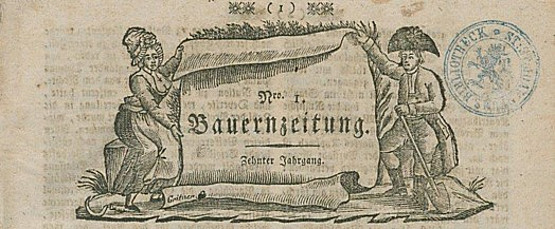Graz Peasant Newspaper
The “Grazer Bauernzeitung” (“Graz Peasant Newspaper”) (1786-1796) and its Innovative Influence on the Newspaper Landscape of the Habsburg Monarchy
The “Grazer Bauernzeitung” comprised the main newspaper with its typical components: current political news, reports on society, economy and culture as well as an appendix with a polyhistoric orientation and an advertisement sheet. The editor, Michael Hermann Ambros (1750-1809), sought to achieve a leading position not only in Graz or Styria, but also in all three parts of the country, including Inner Austria and even in the entire Habsburg monarchy. Correspondents, residing at the focal points covered current events. Ambros then preferably added original educational and discursive contributions to the appendix and advertisers were attracted to publish their advertisements first in the “Bauernzeitung”. He communicated these strategies openly in paratexts. Quantitatively, Ambros was at the forefront of these efforts as the comparison within the lively Graz media landscape, but also with the other media in Inner Austria and beyond shows. This was especially true for his communication with the readership and with the correspondents, which offers a wealth of information on the editorial work and decisions that took place behind the scenes. This openness, that frequently included self-criticism, makes the communication channels tangible. Correspondents can be identified individually, meaning that the reading audience can develop an understanding of their interests, views and professions. Ambros went as far as to broadcast the name of his correspondent in distant Istanbul.
Johann Ambros achieved a new quality and developed unique selling points above all with three initiatives: The 33 marriage announcements of 1794, which were combined into a forum (!), are unparalleled and offer a microcosm not only of gender relationships, but also of the views on gender aspects. From the end of 1791, extracts from advertisements papers (!) from the Habsburg monarchy and the German-speaking world resulted in a unique “meta advertisement sheet”, comprising information on inheritances, the labour market in the Habsburg monarchy, scholarships and ongoing bankruptcy proceedings. This at times intensified, at times neglected category made it possible for the first time to look at the administrative and economic area that had previously only existed in daily reporting. is A considerable yet short-lived networking achievement at the end of 1791 and the beginning of 1792 is the recording of market prices of important trading centers in Inner Austria, Lower Austria, Bohemia and Moravia, in historical Hungary and in Banat. This unofficial “market supervision from below” in the enlightened absolutist Habsburg state is perhaps more revolutionary than any positive comment in the reporting section of revolutionary processes in Europe.
